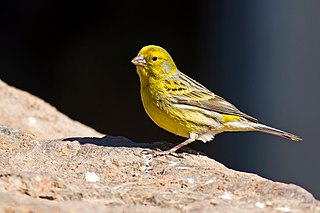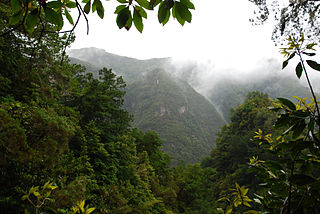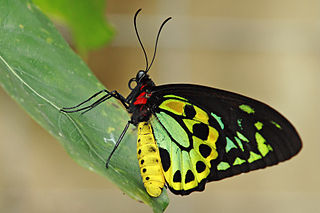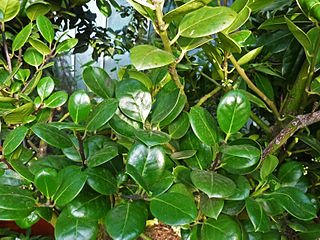
The Atlantic canary, known worldwide simply as the wild canary and also called the island canary, common canary, or canary, is a small passerine bird belonging to the genus Serinus in the finch family, Fringillidae. It is native to the Canary Islands, the Azores, and Madeira. Wild birds are mostly yellow-green, with brownish streaking on the back. The species is common in captivity and a number of colour varieties have been bred.

Pinus canariensis, the Canary Island pine, is a species of gymnosperm in the conifer family Pinaceae. It is a large, evergreen tree, native and endemic to the outer Canary Islands of the Atlantic Ocean.

The trocaz pigeon, Madeira laurel pigeon or long-toed pigeon is a pigeon which is endemic to the island of Madeira, Portugal. It is a mainly grey bird with a pinkish breast; its silvery neck patch and lack of white wing markings distinguish it from its close relative and probable ancestor, the common wood pigeon. Its call is a characteristic six-note cooing, weaker and lower-pitched than that of the wood pigeon. Despite its bulky, long-tailed appearance, this pigeon has a fast, direct flight.

Bolle's pigeon, Bolle's laurel pigeon or dark-tailed laurel pigeon is a species of the genus Columba of family Columbidae, doves and pigeons, endemic to the Canary Islands, Spain. This bird is named after the German naturalist Carl Bolle, who was the first to distinguish it from the laurel pigeon. This wood pigeon is endemic to the laurel forest habitat.

The laurel pigeon or white-tailed laurel pigeon is a species of bird in the Columba genus in the family Columbidae. It is endemic to the Canary Islands, Spain, and resides in laurel forest habitat. It is the animal symbol of the island of La Gomera.

Pieris brassicae, the large white, also called cabbage butterfly, cabbage white, cabbage moth (erroneously), or in India the large cabbage white, is a butterfly in the family Pieridae. It is a close relative of the small white, Pieris rapae.

Pieris, the whites or garden whites, is a widespread now almost cosmopolitan genus of butterflies of the family Pieridae. The highest species diversity is in the Palearctic, with a higher diversity in Europe and eastern North America than the similar and closely related Pontia. The females of many Pieris butterflies are UV reflecting, while the male wings are strongly UV absorbing due to pigments in the scales.

Anthocharis euphenoides, the Provence orange tip, is a species of butterfly in the family Pieridae. It is found in the Iberian Peninsula, in the south of France and in Italy in the Abruzzo. There are a few records from Switzerland. Its caterpillars use Biscutella as their food source.

Laurel forest, also called laurisilva or laurissilva, is a type of subtropical forest found in areas with high humidity and relatively stable, mild temperatures. The forest is characterized by broadleaf tree species with evergreen, glossy and elongated leaves, known as "laurophyll" or "lauroid". Plants from the laurel family (Lauraceae) may or may not be present, depending on the location.

Ornithoptera euphorion, the Cairns birdwing, is a species of birdwing butterfly endemic to Queensland, and is Australia's largest endemic butterfly species. Other common names include Cooktown birdwing and northern birdwing. The names Cairns and Cooktown in its common name reference the Australian cities in the region where this butterfly is found.

Juniperus brevifolia, the Azores juniper, is a species of juniper, endemic to the Azores, where it occurs at altitudes of 240–800 metres, rarely up to 1,500 m (4,900 ft). It is closely related to Juniperus oxycedrus of the Mediterranean region and Juniperus cedrus of the neighboring Macaronesian islands. It is threatened by habitat loss.

The Madeiran large white is a subspecies of the large white butterfly, endemic to Madeira. It was described by the English entomologist, Arthur Gardiner Butler in 1886.

Ilex canariensis, the small-leaved holly, is an endemic species of holly native to Macaronesian islands. It is a species of plant in the family Aquifoliaceae. It is found in the Macaronesian islands of Madeira (Portugal) and Canary Islands (Spain).

Ocotea foetens, commonly called til or stinkwood is a species of tree in the family Lauraceae. It is evergreen and grows up to 40 m tall. It is a common constituent of the laurisilva forests of Madeira and the Canary Islands. Leaf fossils of this species are known from the Mio-Pleistocene of Madeira Island.

Rhamnus glandulosa is a species of plant in the family Rhamnaceae. It is endemic to Madeira and the Canary Islands.

Leptotes webbianus, the Canary blue, is a butterfly in the family Lycaenidae. It is endemic to the Canary Islands.

The wildlife of Spain includes the diverse flora and fauna of Spain. The country located at the south of France has two long coastlines, one on the north on the Cantabrian Sea, another on the East and South East on the Mediterranean Sea, and a smaller one on the west and south west on the Atlantic Ocean, its territory includes a big part of the Iberian Peninsula, the Canary Islands, the Balearic Islands and two enclaves in North Africa, Ceuta and Melilla. The country has many endemic species, especially those restricted to the island groups, and mainly because of the rich geography and the different climate zones, Spain is one of the countries in Europe with the greatest biodiversity.

Ilex perado, the Macaronesian holly, is a species of holly endemic to Macaronesia, distributed throughout the Azores, Madeira and Canary islands. It is an important component of the natural high-altitude Macaronesian rainforest, known as 'laurisilva', found mostly at 500 to 1,200 m altitude but it also appears in forest formations at lower elevation. Many of the subspecies have been classified as threatened, probably because of very small population sizes, and are protected by local, national and regional legislation.




















